Barging in England
Overview of Barging on the River Thames
The River Thames is the longest river entirely within England (215 miles / 346km long), rising at Thames Head in Gloucestershire and flowing into the North Sea at the Thames Estuary. The river is tidal in London with a rise and fall of 23 feet (7 meters) and becomes non-tidal at Teddington Lock. Teddington Lock is a complex of three locks and a weir on the River Thames in England at Ham in the western suburbs of London. The Thames catchment area covers a large part of South Eastern and Western England and the river is fed by over 20 tributaries. The river contains over 80 islands, and by having both seawater and freshwater stretches, it supports a variety of wildlife.
HAMPTON COURT PALACE – SHEPPERTON – RUNNYMEDE – SAVILL GARDEN – WINDSOR CASTLE – DORNEY COURT – MILTON MANOR HOUSE – COOKHAM – HURLEY – HENLEY ON THAMES
Hampton Court Palace
Hampton Court Palace is a royal palace in the London Borough of Richmond upon Thames in southwest London. Hampton Court Palace was a royal residence from the 1520s when King Henry VIII took over its development from Cardinal Wolsey. It has not been lived in by the British royal family since the 18th century.
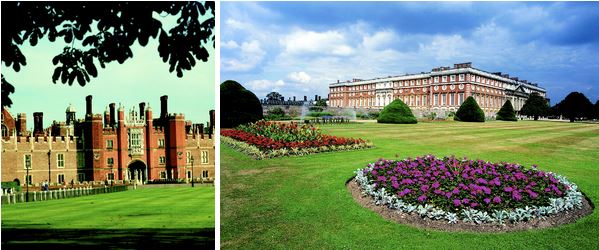
Its many royal occupants have ensured the palace has stunning furnishings, tapestries, and paintings. Hampton Court Palace contains an important part of the largest private collection of art in the world, the Royal Collection, the property of Her Majesty Queen Elizabeth II. This collection at Hampton Court contains material from the 16th, 17th, and early 18th centuries.
The Hampton Court Palace estate includes 60 acres of formal gardens, requiring 200,000 flowering bulbs each year and another 40,000 plants grown in the nursery. The palace's Home Park is the site of the annual Hampton Court Palace Festival and Hampton Court Palace Flower Show. Along with St. James's Palace, it is one of only two surviving palaces out of the many owned by Henry VIII.
Shepperton
Shepperton is a town in Surrey, whose name is derived from "Shepherd's Town". Shepperton Studios is located here. Many films such as Carol Reed's "The Third Man", Harry Enfield's "Kevin and Perry Go Large", Kenneth Branagh's "Frankenstein", and John Huston's "The African Queen" were made at Shepperton. This town was also the home of author J. G. Ballard and provides the setting for his novel "The Unlimited Dream Company". Shepperton also gets a mention in the novel "The War of the Worlds" by H.G. Wells in which its destruction is described.
Runnymede
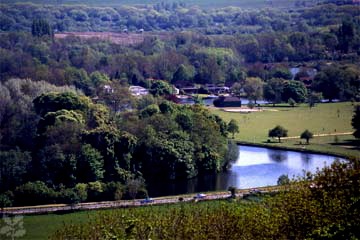
Runnymede is an attractive area of riverside meadows, grassland and broad-leaved woodland. It was on this site in 1215, that King John sealed the Magna Carta. A network of footpaths links the Magna Carta memorial with two others: one to the late American President, John F. Kennedy, and one to the 20,000 Royal Air Force airmen killed in the Second World War, who have no known grave.
Savill Garden
The Savill Garden is one of Britain's greatest ornamental gardens. This 35-acre woodland garden within Windsor Great Park was created in 1932 by Sir Eric Savill from an undeveloped area of the Great Park. It never fails to charm visitors who come to explore its contemporary and classically designed gardens and exotic woodland.

It began as a woodland garden, with native oak, beech and sweet chestnut trees, but has since evolved by incorporating many new plants over the years. The Savill Garden is a place of constant discovery, and of hidden, interlocking gardens, containing distinctive planting groups including areas such as Spring Wood, The Summer Wood, The Hidden Gardens, The Summer Gardens, The Glades, Autumn Wood, The Azalea Walks and The New Zealand Garden. The Savill Garden mixes native and exotic species and has bred many important garden hybrids.
Each "garden within a garden" has its own attractions, and they are ever-changing with every season bringing new colour and interest to delight the visitor. The Savill Garden offers stunning seasonal displays of rhododendron, azaleas and camellias in spring, summer vitality in the Herbaceous Borders, Rose Garden, Dry and Golden Jubilee Gardens, glorious autumn colours and Winter Beds. There is also a unique Temperate House which shelters frost-tender plants from the rigours of winter and is a fragrant delight in spring. Savill Garden is widely recognised as one of the finest woodland gardens in the country.
Windsor Castle
Windsor is the oldest and largest occupied castle in the world and is the Official Residence of Her Majesty The Queen. Its rich history spans over 900 years. Windsor Castle covers an area of approximately 13 acres (5 hectares) and contains magnificent State Apartments furnished with treasures from the Royal Collection, St George's Chapel (one of the most beautiful ecclesiastical buildings in England and the burial place of 10 monarchs), and Queen Mary's Dolls House, a masterpiece in miniature.

Windsor Castle remains a working palace today. The Queen uses the Castle both as a private home, where she usually spends the weekend, and as a Royal residence at which she undertakes certain formal duties. Every year The Queen takes up official residence in Windsor Castle for a month over Easter (March-April), known as Easter Court. During that time The Queen hosts occasional "dine and sleeps" events for guests, including politicians and public figures. The Queen is also in residence for a week in June, when she attends the service of the Order of the Garter and the Royal Ascot race meeting.

Windsor Castle is often used by The Queen to host State Visits from overseas monarchs and presidents. Foreign Heads of State enter the Castle in horse-drawn carriages through the George IV Gateway into the quadrangle in the Upper Ward, where a military guard of honour is drawn up. The traditional State Banquet is held in St George's Hall (55.5m long and 9m wide), with a table seating up to 160 guests.
St George's Chapel remains an active centre for worship, with daily services open to all. Various departments of the Royal Household are based at Windsor Castle. The ancient Round Tower houses the Royal Archives and the Royal Photograph Collection.
When The Queen is in official residence, Changing of the Guard provides a colorful spectacle in the quadrangle.
Dorney Court
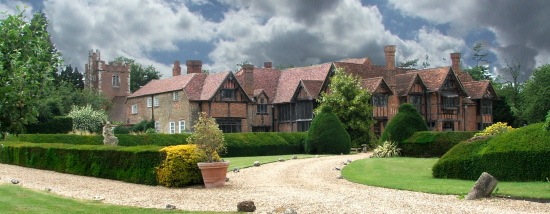
Dorney Court is one of the finest Tudor Manor Houses in the country, and is located a few miles beyond Windsor and Eton. Built in 1440, it has been the home of the Palmer family for more than 450 years, passing from father to son through thirteen generations, and is still lived in today. Much of the house is open to the public, and is well worth a visit. Curiously, the first pineapple ever to be grown in England was grown at Dorney Court, and presented to Charles II in 1661.
Milton Manor House
The Milton Manor House was built in 1663 with wings and outbuildings added in 1772. It is an extraordinarily beautiful family house traditionally designed by Inigo Jones, with a celebrated Gothick library and a beautiful Catholic chapel. Outside, there is extensive parkland with fine old trees, an attractive walled garden, two lakes to picnic by, pony rides for the children, rare breed pigs and sheep, a llama and other animals. Plenty to see and enjoy for all ages. Tearooms are situated in the old kitchens, which also house a large teapot collection.
Cookham

The area has been inhabited for thousands of years. There were several prehistoric burial mounds on Cock Marsh which were excavated in the 19th century and the largest stone axe ever found in Britain was one of 10,000 that has been dug up in nearby Furze Platt. The Roman Road, called the Camlet Way, is reckoned to have crossed the Thames at Sashes Island, now cut by Cookham Lock, on its way from St. Albans to Silchester.
The village of Cookham is a popular tourist destination, as it is a convenient base for a number of walks along the Thames Path and across National Trust property. There are a good selection of restaurants and pubs in the High Street. The Stanley Spencer Gallery, based in the former Methodist chapel, also has a permanent exhibition of the artist's works.
- Keneneth Grahame
Kenneth Grahame is said to have been inspired by the River Thames at Cookham to write The Wind in the Willows, as he lived at "The Mount" in Cookham Dean as a child. Quarry Wood in nearby Bisham, is said to have been the original "Wild Wood". Grahame later lived in Winkfield, Blewbury and Pangbourne.
- Stanley Spencer
The famous English painter Sir Stanley Spencer (1891-1959) was born here and many of his works depict villagers and village life in Cookham. His religious paintings usually had Cookham as their backdrop and a number of the landmarks seen in his canvases can still be seen in the village. The Stanley Spencer Gallery was opened in 1962 in a Methodist Chapel that Spencer attended as a child with his mother. Not far from the gallery is "Fernlea", the cottage where Spencer was born and lived in Cookham High Street. In 2007 the Gallery was awarded a grant from the Heritage Lottery Fund which enabled the former Methodist chapel to be transformed into a stunning exhibition space. It has a wonderful collection of more than 100 of his paintings and drawings. Two exhibitions are held each year. There is a fine archive of photographs, books and other written material. He also painted frescoes in at least one of the private houses in Cookham; however, they are not open to public viewing. He is buried in the churchyard in the village.
Hurley
Hurley is a village and civil parish in the English county of Berkshire. This village is famous for its proximity to the River Thames and is within easy reach of Henley, Oxford and London. The parish includes the villages and hamlets of Cockpole Green, Warren Row, Knowl Hill, Burchett's Green and part of Littlewick Green. Hurley is an affluent area and house prices are higher than the national average. The old manor estate of Hall Place (1728) is now the home of Berkshire College of Agriculture.
Hurley is often used as a mooring for barges and motor launches, or by campers. The weir at Hurley Lock is considered the premier venue in the United Kingdom for freestyle kayaking. The village is home to "Ye Olde Bell" reputedly the oldest, still working, inn in Britain, founded in 1135 as the hostelry of Hurley Priory. Cricket has been played in Hurley for over 100 years. The club currently plays in the Chiltern League on Saturdays and friendly fixtures against local rivals on Sundays. The beautiful ground is typified with an Old English plane tree that lies within the boundaries.
A riverside picnic scene in the James Bond film "From Russia With Love" was filmed near the village.
- Peter Freebody's boatyard

This is definitely a "must see" for those interested in boats. They design, build and restore every type of launch from the smallest dinghy through to electric canoes, motor launches - slipper, saloon, electric, petrol and steam up to 80 feet. Peter Freebody & Company state that they are the most prolific builders and restorers of the greatest variety of river and lake craft in timber in the UK. Established at Hurley since 1933 (prior to that at Caversham) the Freebody family have a history of trading on the River Thames for over 300 years.
Take a look at their website at http://www.peterfreebody.com.
Henley On Thames
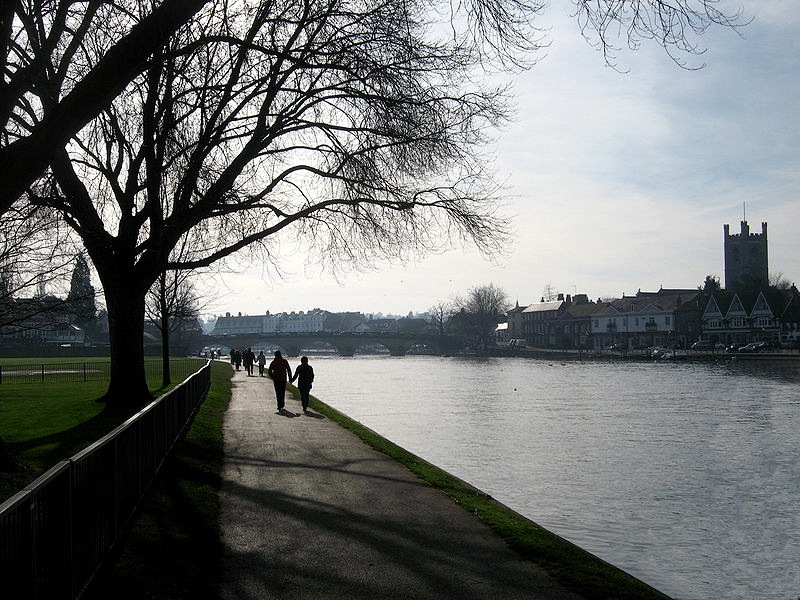
Founded in the 12th century, Henley on Thames is overlooked by beautiful Chiltern landscape of wooded hills and green fields. Just a few strides from the riverbank is the very heart of Henley with its historic church, town hall and market square. The square bustles with busy stall-holders and shoppers on market days. There are also many boutiques for shoppers to browse and enjoy.
Henley, best known for the annual Royal Regatta, attracts some of the world's finest rowers. Statues of great Olympians Sir Steve Redgrave and Sir Matthew Pinsent, greet visitors to the town's award-winning River and Rowing Museum.
Henley also attracts golfers to local courses, and is home to a rugby club (Henley Hawks), along with a successful cricket team, and football clubs. They also have a privately-owned polo ground.
The stretch of river between the regatta finish and Henley Bridge is the location for the annual Henley Festival of Music and Arts. Now a popular hospitality venue it attracts some of the world's top entertainers to perform on a floating stage in front of a dinner-jacketed audience and the site includes exhibitions of art and sculpture. The thriving Kenton Theatre is one of the oldest performing theatres in the country.
- River and Rowing Museum

Set on the banks of the River Thames in Henley-on-Thames, the award-winning River & Rowing Museum has three permanent galleries devoted to the River Thames, the international sport of rowing, and the town of Henley on Thames.
Newly opened in summer 2006 is the Schwarzenbach International Rowing Gallery. This completely refurbished gallery full of interactive exhibits and video footage tells the story of international rowing from 19th Century professionals to modern Olympians. Experience the thrill of racing at Henley Regatta in the world's only "In the Cox's Seat" interactive experience.
There is also a permanent walk-through attraction of Kenneth Grahame's The Wind in the Willows. The famous illustrations of EH Shepard are brought to life in an enchanting recreation of the English classic.
The Thames Gallery is the largest of the River & Rowing Museum's permanent galleries. It provides a unique interpretation of the River Thames from source to sea.
- Rowing Regatta
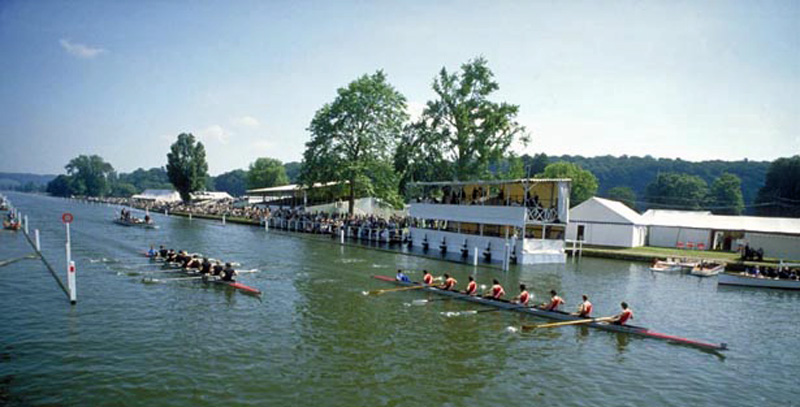
The Henley Royal Regatta is a rowing event held every year on the River Thames by the town of Henley-on-Thames, England. This is one of the highlights of the social calendar of the English middle and upperclasses. The regatta is held on a stretch of the river that is naturally straight. The event became Royal in 1851 when Prince Albert became the patron of the regatta.
The regatta lasts for 5 days (Wednesday to Sunday) over the first weekend in July. Races are head-to-head knock out competitions, raced over a course of 1 mile, 550 yards (2,112 m). The regatta regularly attracts international crews to race. The most prestigious event at the regatta is the Grand Challenge Cup for Men's Eights, which has been awarded since the regatta was first staged.
The Royal Regatta is sometimes referred to as Henley Regatta which is its original name pre-dating Royal patronage. It should not be confused with the three other regattas rowed over approximately the same course (Henley Women's Regatta, Henley Veterans Regatta and Henley Town and Visitors Regatta), each of which is entirely separate.
English Hotel Barges - Barging in England
Hotel Barge Magna Carta
Upper Thames (London-Henley)
up to 8 guests
Charters and Cabin cruises
Many interesting theme charters
HAMPTON COURT PALACE - SHEPPERTON - RUNNYMEDE - SAVILL GARDEN - WINDSOR CASTLE - DORNEY COURT - MILTON MANOR HOUSE - COOKHAM - HURLEY- HENLEY ON THAMES


